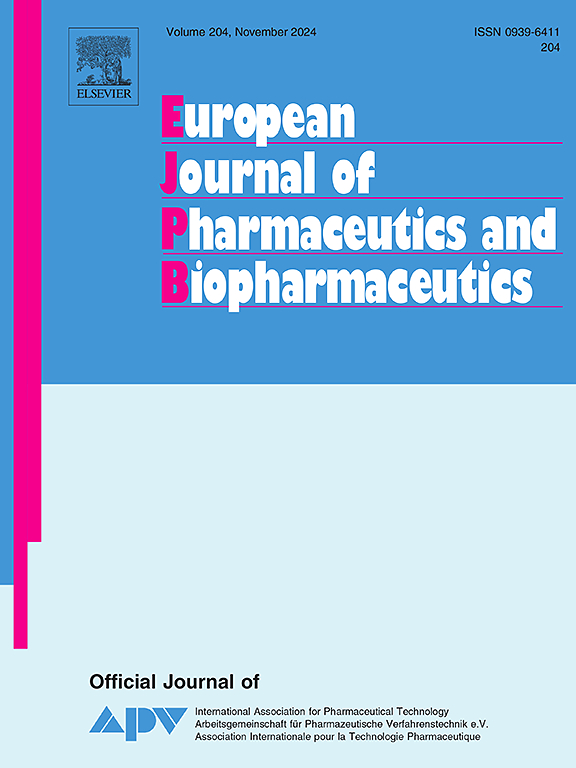Impurity profiling of PEGylated myristoyl diglyceride, DMG-PEG 2000, a functional excipient used in mRNA lipid nanoparticle formulations
IF 4.3
2区 医学
Q1 PHARMACOLOGY & PHARMACY
European Journal of Pharmaceutics and Biopharmaceutics
Pub Date : 2025-06-04
DOI:10.1016/j.ejpb.2025.114762
引用次数: 0
Abstract
Lipid nanoparticles have gained significant attention during the COVID-19 pandemic, particularly due to their role in mRNA vaccine delivery. However, their rapid advancement has outpaced the development of established harmonized protocols for the quality control of the various excipients. In this study, we focused on the “stealth” lipopolymer 1,2-dimyristoyl-rac-glycero-3-methoxypolyethylene glycol-2000 (DMG-PEG 2000), a critical excipient used in Moderna’s Spikevax® mRNA vaccine. We investigated different commercial batches of DMG-PEG 2000 for impurities originating from both synthesis and degradation. Synthesis-related impurities include free glycerol and fatty acids of varying chain lengths, while degradation products result from single or double hydrolysis reactions. These synthetic and degradation-related impurities were primarily analyzed using an optimized high-performance liquid chromatography method with a charged aerosol detector (HPLC-CAD). Applying this validated method, a high purity of commercially available DMG-PEG 2000 was revealed, with every batch investigated exceeding a purity of 98.5%. In addition, gas chromatography (GC), HPLC with an evaporative light scattering detector (HPLC-ELSD), and matrix-assisted laser desorption/ionization time-of-flight (MALDI-TOF) mass spectrometry were employed for comparative purposes and to enable further characterization. Based on these analyses, we developed a streamlined and robust impurity profiling protocol that (i) provides essential insight into the impurity profile of DMG-PEG 2000 in marketed products and (ii) may facilitate more decentralized and standardized validation processes in the future. The analytical approach presented here may also serve as a foundation for a future pharmacopeial monograph proposal for DMG-PEG 2000.

聚乙二醇肉豆醇二甘油酯的杂质分析,DMG-PEG 2000,一种用于mRNA脂质纳米颗粒配方的功能赋形剂。
脂质纳米颗粒在COVID-19大流行期间引起了极大的关注,特别是由于它们在mRNA疫苗递送中的作用。然而,它们的快速发展已经超过了各种赋形剂质量控制的既定协调协议的发展。在这项研究中,我们重点研究了“隐形”脂聚合物1,2-二myristoyl- racc -glycero-3-methoxypolyethylene glycol-2000 (DMG-PEG 2000),这是Moderna的Spikevax®mRNA疫苗中使用的一种关键辅料。我们研究了不同商业批次的DMG-PEG 2000在合成和降解过程中产生的杂质。与合成相关的杂质包括游离甘油和不同链长的脂肪酸,而降解产物是由单次或双次水解反应产生的。这些合成和降解相关的杂质主要使用优化的高效液相色谱法与带电气溶胶检测器(HPLC-CAD)进行分析。应用该验证方法,发现了高纯度的市售DMG-PEG 2000,每个批次的纯度都超过98.5%。此外,气相色谱法(GC)、高效液相色谱法(HPLC with蒸发光散射检测器(HPLC- elsd))和基质辅助激光解吸/电离飞行时间(MALDI-TOF)质谱法被用于比较目的和进一步的表征。基于这些分析,我们开发了一种简化且强大的杂质分析方案,该方案(i)提供了对已上市产品中DMG-PEG 2000杂质概况的基本见解,(ii)可能促进未来更分散和标准化的验证过程。这里提出的分析方法也可以作为未来DMG-PEG 2000药典专著提案的基础。
本文章由计算机程序翻译,如有差异,请以英文原文为准。
求助全文
约1分钟内获得全文
求助全文
来源期刊
CiteScore
8.80
自引率
4.10%
发文量
211
审稿时长
36 days
期刊介绍:
The European Journal of Pharmaceutics and Biopharmaceutics provides a medium for the publication of novel, innovative and hypothesis-driven research from the areas of Pharmaceutics and Biopharmaceutics.
Topics covered include for example:
Design and development of drug delivery systems for pharmaceuticals and biopharmaceuticals (small molecules, proteins, nucleic acids)
Aspects of manufacturing process design
Biomedical aspects of drug product design
Strategies and formulations for controlled drug transport across biological barriers
Physicochemical aspects of drug product development
Novel excipients for drug product design
Drug delivery and controlled release systems for systemic and local applications
Nanomaterials for therapeutic and diagnostic purposes
Advanced therapy medicinal products
Medical devices supporting a distinct pharmacological effect.

 求助内容:
求助内容: 应助结果提醒方式:
应助结果提醒方式:


